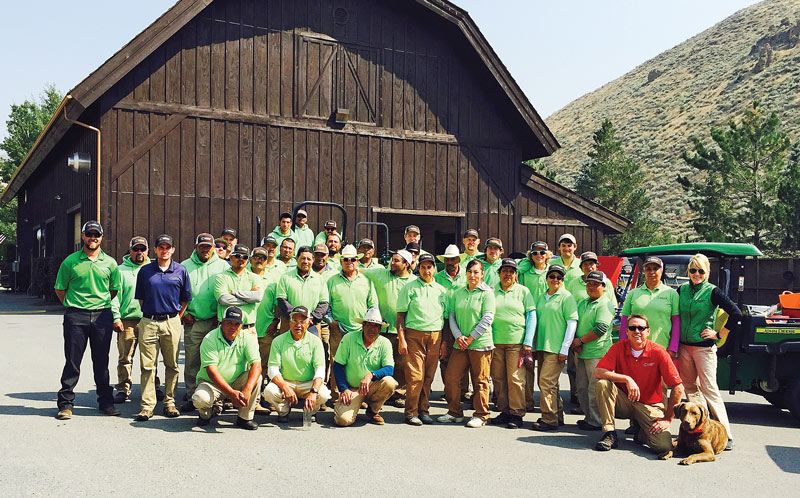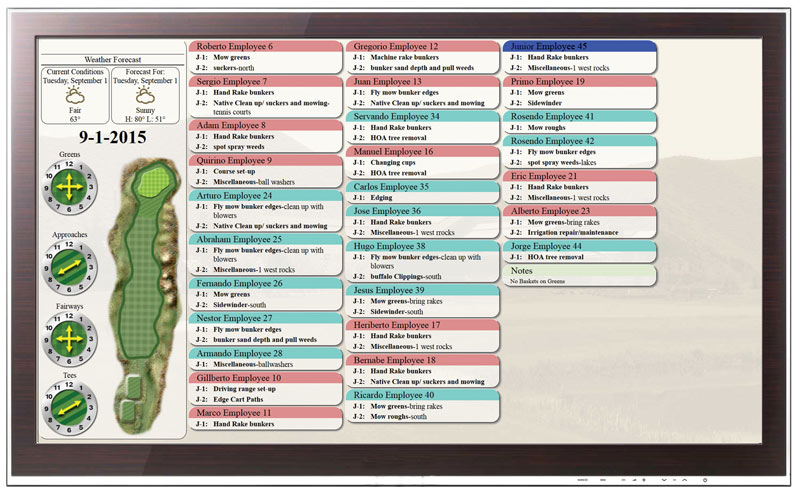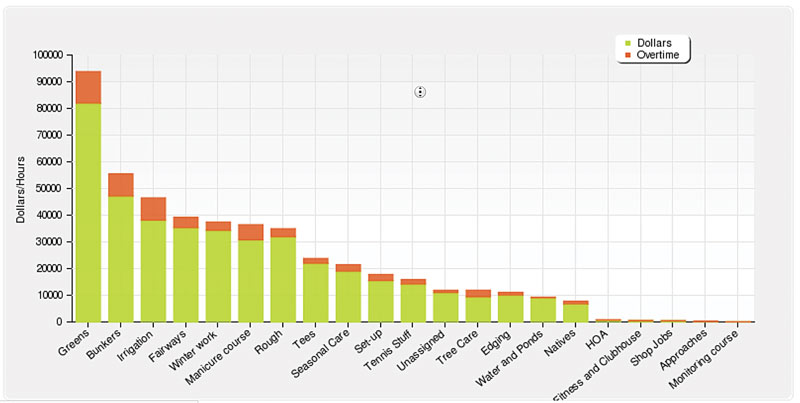
The golf course maintenance crew and the landscape crew at The Valley Club in Hailey, Idaho. Photos courtesy of Gerald Flaherty
I have worked at golf courses from New Jersey to Hawaii, and in my 17 years as a superintendent, I have used various techniques for delegating and tracking daily job assignments for crew members. I always thought it was peculiar that we monitored the cost to maintain equipment but no one seemed worried about tracking how labor dollars were spent.
Since starting at The Valley Club in Hailey, Idaho, in 2007, I had been writing job assignments on a whiteboard in the shop break room, and at the end of every day, I would erase all of that valuable information — who did each job, how long the job took, and more. I found using the whiteboard and wiping away its contents each evening to be inefficient and frustrating, so one day, I decided to act on an idea that, frankly, wasn’t even that original. In fact, many others have had the same idea, but with the help of my golf pro, Jaime Sharp, who has an unlikely hobby, I was able to turn the idea into a program with innovative capabilities.
Thanks to the tool, which came to be known as “taskTracker,” I can now say with confidence what it costs to maintain bunkers, have fast green speeds, hand-water fairways, take care of the tennis courts, and dozens of other tasks.
Retaining info; upping efficiency
The problem was straightforward: How do you accurately track labor hours and the amount of money spent on each of the tasks carried out on the course throughout the season? Almost every superintendent uses a whiteboard to assign jobs for the day, and every superintendent then erases that whiteboard to make room for the next day’s jobs. I knew the answer wasn’t just to make an Excel spreadsheet, or to have my employees fill out a task sheet and then record that data digitally later. Those methods can be time-consuming and inaccurate.
My idea was to use an HDTV as the new whiteboard. I wanted to create an electronic whiteboard — an e-board, if you will — where tasks could be posted faster than they could be written down, and that could give employees updates in real time. Job duties would be tied to an employee, and the employee would be tied to a wage. All data would be stored automatically and be easy to retrieve, and the program would be simple enough that I could use it every day.
I first mentioned the idea to Jaime in February 2013. Jaime, who has been at The Valley Club for 12 years, has extensive knowledge of golf course operations as well as database management, HTML and other similar concepts with acronyms that would only have meaning to the geekiest of geeks.

The display board detailing crew member assignments and other daily notes can be streamed to a TV, projector or smartphone.
Working with Jaime was easy — I simply explained to him our daily routine, what data I wanted to collect, and how I wanted the display board to appear on the big-screen television. In about a week, Jaime had built a Web-based application that completely exceeded my expectations and would prove to be a perfect marriage of cutting-edge features and real-world utility. Job assignments could be entered into the program with ease from a computer or any mobile device, and those assignments were then streamed to the HDTV in the break room, as well as to crew members’ smartphones. Because the program is Web-based, my employees and I are no longer chained to the whiteboard to assign and receive jobs throughout the day — everything can now be done in the field and on the go. Today, the entire golf course maintenance crew of 33 employees as well as the six-person landscape crew receive and record their daily tasks via taskTracker.
Doing more with data
Now for the real innovation. Data is just data, and gathering it is relatively easy. However, it is difficult to display data for practical purposes. I knew the type of reports I wanted that would provide an accurate picture of how labor was being used on the course. Jaime refined my vision, giving taskTracker the ability to render data visually and generate customized reports. These reports have become an integral part of my budgeting process.
In addition to translating labor data into clear, constructive charts and graphics, taskTracker also gives insight into other financial matters that affect the bottom line. An example of this is when superintendents are asked to do labor-intensive projects that are outside of their department. In most cases, superintendents are not given financial credit for these tasks — the work is simply absorbed into the golf course maintenance budget. With the ever-increasing pressure to produce more with less, these projects only make meeting financial goals harder, leaving the superintendent holding the bag. With taskTracker, I have been able to prove that even though my budget may not be decreasing, I am doing more with less, which demonstrates that my operation is becoming more efficient.

Based on the data you input, taskTracker can create a number of helpful charts and graphs. This one breaks down the spending for each task, allowing the superintendent to identify where the most labor dollars are being spent.
Knowing how much money it takes to maintain a square foot of green, bunker, rough, native and tee is valuable data when deciding whether to widen fairways or increase rough, all of which have financial impacts. The taskTracker also enables me to calculate the return on investment of purchasing a piece of equipment versus using manual labor, allowing me to make a compelling argument on the cost savings. Being able to show the board of directors and the club members where my largest budget line item — labor — is spent gives my team and me immense credibility and job security.
Ample appeal
Like any superintendent with a new tool at his disposal, I proudly showed taskTracker to other superintendents, first at the local Idaho GCSA meeting in October 2013. A couple of superintendents found it interesting and wanted to try the program on their courses. That was when the other light bulb went off, and Jaime and I realized I wasn’t the only superintendent frustrated by erasing my course’s daily labor history.
With the help of Twitter and a few regional superintendents who believed in us, word of taskTracker spread, and in its first year of availability, it has been used across the country as well as internationally by some of the top superintendents. Having the power to collect and display labor data has led to more efficient work and better budgeting for superintendents. The taskTracker also continues to gain attention for its ability to free superintendents of the shackles of data entry, giving us the opportunity to spend more time on the course, doing what we love. A nice bonus of this project has been the networking and the relationships that have resulted from working with more than 100 superintendents and assistants on taskTracker.
Jaime and I have become business partners and great friends. With Jaime being the head professional and me the golf course superintendent, we have learned about the different roles we each play at the club, and the relationship between the golf shop and golf maintenance has never been better. Jaime does still send that foursome of golfers out 15 minutes early, and they catch the tee mowers. Now, however, I am able to track the additional cost with taskTracker.
Gerald Flaherty, CGCS, is the director of agronomy at The Valley Club, where he has worked since 2007, and the co-founder of taskTracker. He is a 22-year member of GCSAA and lives in Hailey, Idaho, with his wife, Lisa.